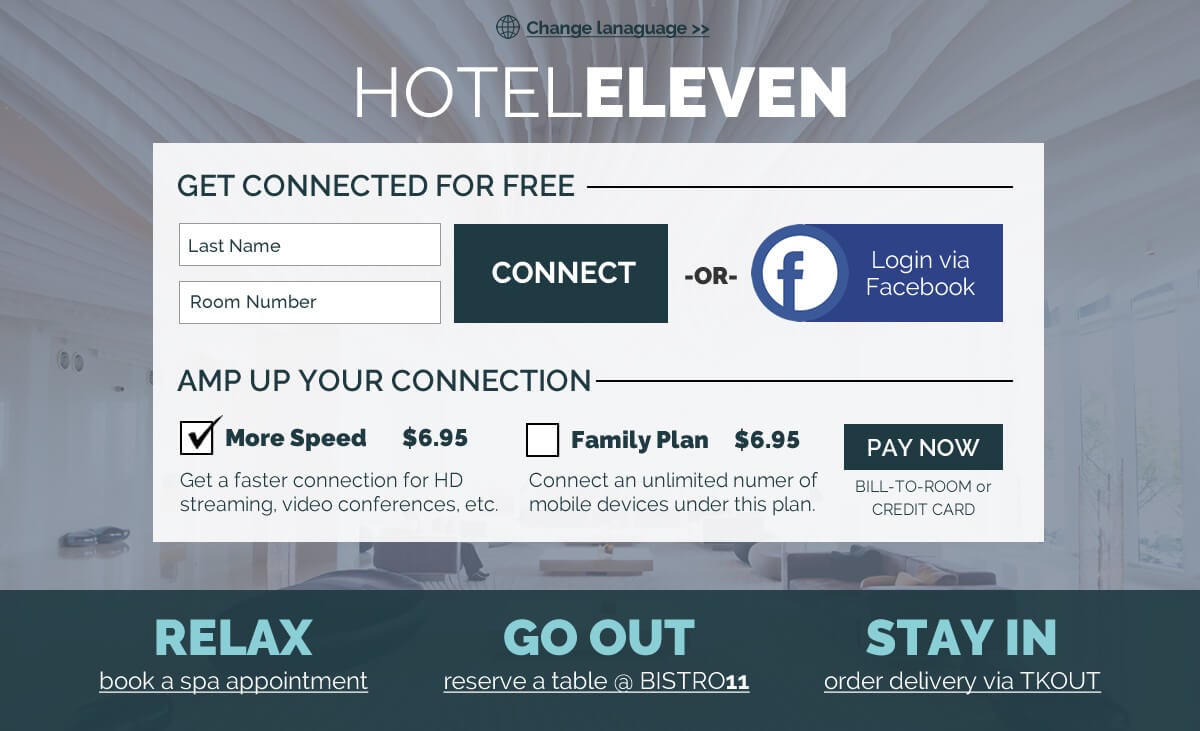Bandwidth, bandwidth, bandwidth. There is never enough. Since guests travel with multiple devices, hotels are having trouble keeping up with the rising bandwidth needs. With large hotels that need to cover public and outdoor spaces as well as conference areas to medium and boutique hotels, Wi-Fi has become essential.
“Hotels need as much bandwidth as they can get,” said Armand Rabinowitz, senior director of Hotel Technology Next Generation’s strategy and workgroups. “The more bandwidth you have, the more you can do. Guests expect a smooth internet experience—they want to stream media content, conduct video conference calls, and review and post to social media. With the Wi-Fi and internet experience so influential over guest satisfaction, procuring the bare minimum is equivalent to expecting nothing more than the minimum satisfaction scores from your customers.”
There are an increasing number of systems that require excellent Wi-Fi for hotel operations as well. Property-management systems, point-of-sale systems and private branch exchanges moving to the cloud was the beginning, but the Internet of Things provides a near endless list of solutions by connecting to the internet.
“Wi-Fi has essentially become a third utility for hotels—after energy and water, the wireless internet network has become a crucial investment,” said John D’Annunzio, GM of North America for Samsung Wireless Enterprise.
In general, bandwidth consumption is driven by four things: the high number of guest devices, the applications those devices are using (such as surfing, streaming, videoconferencing, file sharing, gaming), Internet of Things and the smart hotel room, and back-of-the-house operations.
“Bandwidth requirements can vary considerably based on the objectives of the hotel, the environment of the hotel itself, and the consumption habits of its guests at any given time,” said Coleen Carey, VP of marketing for Eleven Wireless.
Carey said Netflix recommends a range of 1 to 2 megabits per room, which would allow for a good guest experience today, and 2 megabits for future growth, but those numbers are continually going up, Carey warned. Higher-quality video uses more bandwidth than lower-quality video. If your service provider applies a bandwidth or data cap to your internet service, Carey suggested hoteliers can manage bandwidth usage by changing the video quality settings to low or medium to consume less data.
Vijay Patil, network engineer for Gx2 Technology, said the new standard for the best guest Wi-Fi networks is placing access points as close to the end user as possible, which ideally means access points in each guestroom. For new-build hotels, this is easily achieved by adding a network drop in each room. However in older buildings, this can be a problem, Patil said.
“There are workarounds though,” he said. “We can use Cat3 phone lines attached to a [digital subscriber line access multiplexer] but we now have even better options to use existing [coaxial cable] and distributing through a [cable modem termination] system. Properties can the benefit of not having to pay for cabling.”
Patil recommends hotels dedicate a minimum of 200Mb to guest Wi-Fi. “This gives an ample pipeline for heavy streaming on multiple devices for users,” he said. For larger properties, he suggested increasing the bandwidth by the number of rooms or guests; however, this can be worked around with traffic shaping, limiting devices and bandwidth-management tools.
What Distribution Systems can Achieve

Distribution systems haven’t changed dramatically except for the continued expansion of channel-management systems and a gradual increase in the variety of options. In terms of methods, these have been very stable, said David Sjolander, COO of HTNG. But there are changes coming. OpenTravel Alliance has introduced its version 2.0 object model; HTNG has introduced lightweight messaging, mostly for mobile applications; and the International Air Transport Association has introduced new distribution capability.
“Due to these changes, HTNG, in coordination with the OpenTravel Alliance and IATA, has launched a new workgroup, Next Generation Distribution Messaging, to make a recommendation to the industry on the direction we should take,” Sjolander said. “While we, as an industry, want to take advantage of these enhancements, we don’t want to end up in a situation a few years from now where we have competing standards.”
While the group works on the recommendation, some of the goals are to allow for more robust offers and orders, better product differentiation, and the ability to sell all options and amenities through all channels. Another goal is to enable a variety of messaging types that can support traditional and mobile platforms. Providing a seamless travel experience across different verticals, such as air, hotel, rail and car is yet another goal.
How to Manage Wi-Fi Updating Costs

Once the infrastructure has been saturated, it’s time to make the investment into the next generation of network technology. For decades, fiber has been the best way to avoid obsolescence, according to HTNG’s Rabinowitz. It is easy to swap out the electronic components connected to a fiber plant.
“Fiber doesn’t degrade, but copper wires can,” he said. “However technology and science are making strides in better use of copper wiring. Smaller properties can expect many years or even decades of use from an upgraded copper plant. Larger properties should analyze the long-term cost benefit for a gigabit passive optical network.”
Existing properties should budget for upgrading their internal Wi-Fi networks about every four years because technology evolves quickly and so does guest behavior, said Craig Snelgrove, VP of business development for Bulk TV and Internet. Properties should ensure they receive a professional site survey and installation from a reputable provider, as well.
“Take advantage of the timing of any property-improvement programs—adding wiring for greater Wi-Fi backhaul and density, or the implementation of [over-the-top] services at the television, is much less disruptive during the time a property is being renovated,” he said.
Installing a new Wi-Fi solution in a hotel can be a costly expense, but Patil said sometimes hotels don’t necessarily need upgrades to the entire system but fixes to particular problems.
“We believe we need to start with the problem before we design an upgrade solution,” he said. “We have to understand what the complaints are, where they are have poor coverage, and then survey the property before we design a new solution. Once we understand the issues and the existing infrastructure, then we can help design a cost effective upgrade, working within a hotel’s budget.”
Carey suggested a variety of different options to help with Wi-Fi renovation costs. Using tiered bandwidth levels is an easy way that many hotels currently use. The free level can be used for basic services such as web surfing and email while hotels can create one or two additional premium tiers for steaming and video conferencing. “Guests are happy to pay for what they want to use, we’ve found,” she said.
Charging for Wi-Fi services in the conference rooms and meeting areas, advertising on the guest portal, and “leasing” space on the Wi-Fi network to carriers during nonpeak times are all great options that hotels are currently taking advantage of, Carey said.
